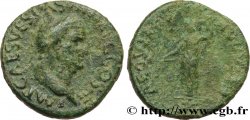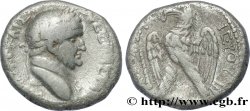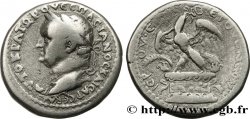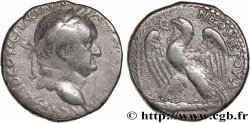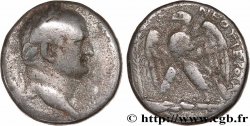E-auction 164-100523 - bpv_141593 - VESPASIANO Tétradrachme syro-phénicien
Devi Sign-in ed essere un offerente approvato fare un'offerta, Login per fare offerte. Conti sono soggetti ad approvazione e di approvazione sono raggiunti entro 48 ore. Non aspettare fino al giorno di una vendita si chiude per registrarti.Confermando la tua offerta su questo oggetto ti impegni ad un contratto legalmente vincolante per l'acquisto di questo prodotto e fare clic su «offerta» costituisce accettazione dei termini di utilizzo de e-auctions cgb.fr.
Offerta deve essere collocato in euro gli importi interi vendita only.The si chiuderà al momento sulla descrizione dell'oggetto, eventuali offerte pervenute al sito dopo l'orario di chiusura non verranno eseguite. Volte transmition possono variare e le offerte potrebbero essere respinto se si attende per gli ultimi secondi. Per ulteriori informazioni ckeck le FAQ.
SENZA COSTI PER GLI ACQUIRENTI.
SENZA COSTI PER GLI ACQUIRENTI.
| Valutazione : | 280 € |
| Prezzo : | 106 € |
| Offerta maxima : | 218 € |
| Data di fine vendita : | 06 giugno 2016 15:13:00 |
| partecipanti : | 5 partecipanti |
Tipo : Tétradrachme syro-phénicien
Data: an 2
Nome della officina / città: Antioche, Syrie, Séleucie et Piérie
Metallo : argento
Diametro : 26 mm
Asse di coniazione : 11 h.
Peso : 14,53 g.
Grado di rarità : R2
Commenti sullo stato di conservazione:
Léger décentrage qui oblitère la fin de la légende de droit, léger tréflage au revers, usure régulière de circulation
N° nelle opere di riferimento :
Pedigree :
Cet exemplaire est le 0105_009 de la base TSP, il provient de la trouvaille dite de Cisjordanie
Diritto
Descrittivo diritto : Tête laurée de Vespasien à droite (O1).
Legenda diritto : AUTOKRAT KAISA OUESPASIANOU
Traduzione diritto : (L'empereur césar Vespasien).
Rovescio
Descrittivo rovescio : Aigle, ailes écartées, à droite sur un foudre, palme verticale dans le champ droit.
Legenda rovescio : ETOUS NEOU IEROU B
Traduzione rovescio : (Nouvelle année sainte An 2).
Commento
Curieusement, ce qui se rapproche le plus de ces émissions du premier groupe de Vespasien, fort rare, caractérisé par un aigle sur foudre à droite, ce sont aussi bien les émissions du milieu du règne de Néron (Prieur 84 à 89), de dix ans antérieures, que les premières émissions du règne de Domitien. (Prieur 143). Faut-il en déduire qu’il était politique à Antioche, pour un nouvel empereur du premier siècle, de rappeler le souvenir de ces frappes de Néron ?
Ce premier groupe, placé là d’une manière arbitraire (il comporte les années A et B, mais comme les groupes 5, 6 et 9), n’a aucun rapport avec les émissions de Galba et d’Othon : faut-il en déduire qu’il n’a pas été frappé à Antioche ou que les frappes de ceux-ci émanent d’une autre ville ? La question reste encore posée. On remarque par ailleurs que les aigles de ce groupe ne portent pas la couronne dans le bec, probablement une distinction accordée à la ville émettrice.
Le premier groupe se termine en l’an 2, numériquement, c’est l’un des plus réduits de l’ample production liée à la guerre Juive. Cette variante à buste nu manque aux Cabinets des Médailles de Paris et de Londres.
Les sigma sont traités en C.
Dans la base TSP maintenue par Michel Prieur, quatorze exemplaires seulement sont maintenant répertorié, dont seulement trois en musées Berlin, Fitzwilliam Museum Mc Lean Collection et Vienne.
Curiously, what comes closest to these issues of the first group of Vespasian, very rare, characterized by an eagle on a thunderbolt on the right, are both the issues from the middle of the reign of Nero (Prior 84 to 89), from ten years earlier, and the first issues of the reign of Domitian.. (Prior 143). Should we deduce from this that it was political in Antioch, for a new emperor of the first century, to recall the memory of these strikes of Nero? This first group, placed there arbitrarily (it includes years A and B, but like groups 5, 6 and 9), has no connection with the issues of Galba and Otho: should we deduce from this that it was not struck in Antioch or that the strikes of these emanate from another city? The question still remains.. It is also noted that the eagles in this group do not wear the crown in their beaks, probably a distinction granted to the issuing city..
The first group ends in the year 2, numerically, it is one of the smallest of the large production linked to the Jewish War. This bare-bust variant is missing from the Cabinets of Medals in Paris and London.
Sigmas are treated in C.
In the TSP database maintained by Michel Prieur, only fourteen examples are now listed, including only three in museums: Berlin, Fitzwilliam Museum Mc Lean Collection and Vienna.
Ce premier groupe, placé là d’une manière arbitraire (il comporte les années A et B, mais comme les groupes 5, 6 et 9), n’a aucun rapport avec les émissions de Galba et d’Othon : faut-il en déduire qu’il n’a pas été frappé à Antioche ou que les frappes de ceux-ci émanent d’une autre ville ? La question reste encore posée. On remarque par ailleurs que les aigles de ce groupe ne portent pas la couronne dans le bec, probablement une distinction accordée à la ville émettrice.
Le premier groupe se termine en l’an 2, numériquement, c’est l’un des plus réduits de l’ample production liée à la guerre Juive. Cette variante à buste nu manque aux Cabinets des Médailles de Paris et de Londres.
Les sigma sont traités en C.
Dans la base TSP maintenue par Michel Prieur, quatorze exemplaires seulement sont maintenant répertorié, dont seulement trois en musées Berlin, Fitzwilliam Museum Mc Lean Collection et Vienne.
Curiously, what comes closest to these issues of the first group of Vespasian, very rare, characterized by an eagle on a thunderbolt on the right, are both the issues from the middle of the reign of Nero (Prior 84 to 89), from ten years earlier, and the first issues of the reign of Domitian.. (Prior 143). Should we deduce from this that it was political in Antioch, for a new emperor of the first century, to recall the memory of these strikes of Nero? This first group, placed there arbitrarily (it includes years A and B, but like groups 5, 6 and 9), has no connection with the issues of Galba and Otho: should we deduce from this that it was not struck in Antioch or that the strikes of these emanate from another city? The question still remains.. It is also noted that the eagles in this group do not wear the crown in their beaks, probably a distinction granted to the issuing city..
The first group ends in the year 2, numerically, it is one of the smallest of the large production linked to the Jewish War. This bare-bust variant is missing from the Cabinets of Medals in Paris and London.
Sigmas are treated in C.
In the TSP database maintained by Michel Prieur, only fourteen examples are now listed, including only three in museums: Berlin, Fitzwilliam Museum Mc Lean Collection and Vienna.







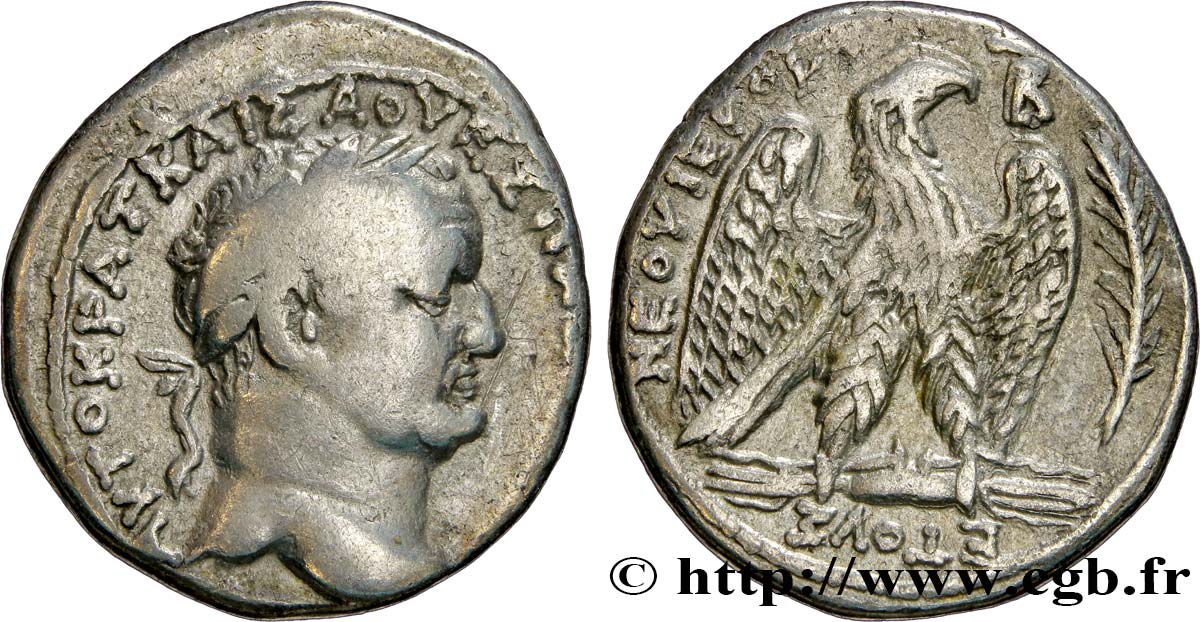
 Segnalare un errore
Segnalare un errore Stampate la pagina
Stampate la pagina Condividi mia selezione
Condividi mia selezione Fai una domanda
Fai una domanda Consegnare / vendere
Consegnare / vendere
 Descrittivo
Descrittivo